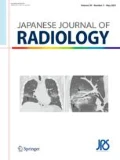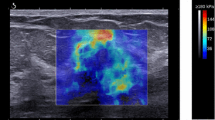Abstract
Purpose
The aim of this study was to perform the phantom experiment and demonstrate the clinical usefulness of tissue quantification using a linear array transducer and acoustic radiation force impulse (ARFI) technology.
Materials and methods
For the phantom study, the commercially available Elasticity QA Phantom Model 049 was used. First, we measured the shear wave velocity (m/s) for the four spheres and the background of the phantom. Then, the shear wave velocity at nine sites was measured, with the region of interest being moved gradually from a shallow region (3 mm) to a deeper region (38 mm). For the clinical study, the shear wave velocities of 15 solid breast mass lesions were measured.
Results
The phantom study confirmed the feasibility of quantitative determination of the degree of tissue hardness. Dispersion of the measured values tended to be somewhat increased for the depths of 3 mm and 38 mm. The mean shear wave velocity was 2.07–2.93 m/s for five benign lesions, whereas higher shear wave velocities (n = 2) (7.15, 7.44 m/s) or “X.XX” (unmeasurable state) (n = 7) were found for malignant lesions other than mucinous carcinoma (2.44 m/s).
Conclusion
ARFI tissue quantification is a potentially promising ultrasonographic technique for diagnosing breast lesions.
Similar content being viewed by others
References
Stavros AT, Thickman D, Rapp CL, Dennis MA, Parker SH, Sisney GA. Solid breast nodules: use of sonography to distinguish between benign and malignant lesions. Radiology 1995;196:123–134.
Zonderland HM, Coerkamp EG, Hermans J, van de Vijver MJ, van Voorthuisen AE. Diagnosis of breast cancer: contribution of US as an adjunct to mammography. Radiology 1999;213:413–422.
Flobbe K, Nelemans PJ, Kessels AG, Beets GL, von Meyenfeldt MF, van Engelshoven JM. The role of ultrasonography as an adjunct to mammography in the detection of breast cancer: a systematic review. Eur J Cancer 2002;38:1044–1050.
Cosgrove DO, Kedar RP, Bamber JC, al-Murrani B, Davey JB, Fisher C, et al. Breast diseases: color Doppler US in differential diagnosis. Radiology 1993;189:99–104.
Raza S, Baum JK. Solid breast lesions: evaluation with power Doppler US. Radiology 1997;203:164–168.
Itoh A, Ueno E, Tohno E, Kamma H, Takahashi H, Shiina T, et al. Breast disease: clinical application of US elastography for diagnosis. Radiology 2006;239:341–350.
Friedrich-Rust M, Wunder K, Kriener S, Sotoudeh F, Richter S, Bojunga J, et al. Liver fibrosis in viral hepatitis: noninvasive assessment with acoustic radiation force impulse imaging versus transient elastography. Radiology 2009;252:595–604.
Lupsor M, Badea R, Stefanescu H, Sparchez Z, Branda H, Serban A, et al. Performance of a new elastographic method (ARFI technology) compared to unidimensional transient elastography in the noninvasive assessment of chronic hepatitis C: preliminary results. J Gastrointest Liver Dis 2009;18:303–310.
Takahashi H, Ono N, Eguchi Y, Eguchi T, Kitajima Y, Kawaguchi Y, et al. Evaluation of acoustic radiation force impulse elastography for fibrosis staging of chronic liver disease: a pilot study. Liver Int 2010;30:538–545.
Gallotti A, D’Onofrio M, Pozzi Mucelli R. Acoustic radiation force impulse (ARFI) technique in ultrasound with Virtual Touch tissue quantification of the upper abdomen. Radiol Med 2010;115:889–897.
Yoneda M, Suzuki K, Kato S, Fujita K, Nozaki Y, Hosono K, et al. Nonalcoholic fatty liver disease: US-based acoustic radiation force impulse elastography. Radiology 2010;256:640–647.
Zhi H, Xiao XY, Yang HY, Wen YL, Ou B, Luo BM, et al. Semi-quantitating stiffness of breast solid lesions in ultrasonic elastography. Acad Radiol 2008;15:1347–1353.
Cho N, Moon WK, Kim HY, Chang JM, Park SH, Lyou CY. Sonoelastographic strain index for differentiation of benign and malignant nonpalpable breast masses. J Ultrasound Med 2010;29:1–7.
Author information
Authors and Affiliations
Corresponding author
About this article
Cite this article
Tozaki, M., Saito, M., Joo, C. et al. Ultrasonographic tissue quantification of the breast using acoustic radiation force impulse technology: phantom study and clinical application. Jpn J Radiol 29, 598–603 (2011). https://doi.org/10.1007/s11604-011-0591-9
Received:
Accepted:
Published:
Issue Date:
DOI: https://doi.org/10.1007/s11604-011-0591-9




